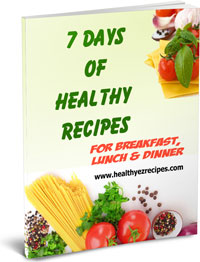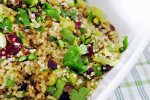Cooking Vegetables without Losing Nutrients

We are told that as part of a healthy diet we must half fill our plate with fruit and vegetables.
But how you prepare and cook them is just as important. Boiling them to a mushy pulp, smothering them with a rich, creamy sauce or drowning them in oil or fat is either going to destroy all their goodness or ramp up the calories so that all the benefits will be lost.
To get the most out of your vegetables handle them with care and attention.
The golden rules of vegetable cooking:
- Reduce the amount of water used
- Reduce the length of cooking time
- Reduce the amount of surface area exposed
- Reduce the amount of added fat
Tips for retaining vitamins during cooking:
Store your vegetables in a cool place or in the crisper section of your refrigerator. Leaving them in direct sunlight results in sad, looking wilted vegetables.
Buy fresh vegetables several times a week. To ensure your vegetables are as fresh as possible when you cook them, try to get to the market several times a week.
Cooking methods such as steaming, stir-frying, baking and microwaving are healthy ways to cook vegetables with little nutrient loss.
Don’t thaw frozen vegetables before cooking.
Peel the skin thinly or leave on altogether. Several nutrients are at their highest concentration just below the skin. Vegetable skins also contain high amounts of fiber.
When cooking vegetables in water, use the smallest amount of water, or better still, steam them.
Cook for the shortest time possible. Remember vegetables should be tender but still slightly crisp. Over-boiling your vegetables is the quickest way of destroying nutrients.
Peel and chop your vegetables just before you are ready to cook them.
When cooked, serve immediately. Keeping them warm destroys Vitamin C.
When roasting vegetables lightly brush with olive oil rather than filling the dish with fat or oil.
Leave the skin on when roasting pumpkin, carrots, parsnips and potatoes. Just scrub them clean.
Never soak vegetables in water prior to cooking or add soda to the cooking water. Both methods destroy Vitamin C.
Healthy Ways to Cook Vegetables
Barbecuing and Grilling

Food is cooked over hot embers or under a hot grill. Vegetables can be threaded onto skewers and brushed with oil, margarine, dressing etc to prevent them burning.
Blanching
This method is used to precook or parboil vegetables before adding them to salads or freezing. The vegetables are immersed briefly in boiling water then dipped into cold water to halt the cooking process. This produces a very bright color and preserves nutrients and flavor.
Boiling
To prepare the vegetables, cut into even-sized pieces. Place in enough boiling water to cover the vegetables. Cover tightly to keep in the steam and bring back to the boil as quickly as possible. Boil gently until tender when tested with a fork.
This method has the greatest loss of nutrients, flavor and color. Sometimes veggies need to be cooked this way, when making potato salad for example. In this instance cook only until just tender.
Steaming

Cut vegetables into even-sized pieces and place in a basket or rack over rapidly boiling water. Don’t let the water touch the vegetables. A few minutes cooking is enough for green vegetables, while root vegetables take a little longer.
This method is preferred to boiling because they cook in steam instead of water. It produces bright colourful vegetables without loss of vitamins or flavour.
Sautéing
Cook sliced or chopped vegetables in a little oil or margarine in a pan over a high heat stirring occasionally. If you use a non-stick pan very little oil needs to be used. Vegetables are often sautéed before adding to soups, stews, casseroles etc.
Stir-frying

Stir-frying is a quick and easy method for cooking vegetables with very little nutrient loss. This because the vegetables are cooked rapidly in a minimum amount of liquid.
Vegetables are usually sliced into thin even-sized pieces to ensure quick and even cooking.
Heat a little oil in a large frying pan or wok. When the oil is hot add the vegetables and toss and stir to keep them moving so they are well coated.
Pour in a little liquid. The steam finishes off the cooking process.
Baking and Roasting
This method is particularly suitable for potatoes, kumara, pumpkin and yams. Peppers, courgettes, onion, pumpkin and squash can be stuffed and also cooked this way.
Peel only if necessary. Many vegetables can simply be scrubbed with the skins left unpeeled. Cut large vegetables into smaller chunks, and leave smaller ones whole. Brush with a little oil and cook in a moderately hot oven.
Tip
After cooking vegetables keep any cooking liquid that remains and use as liquid for sauces, soups and stocks.
Home » Vegetables » Cooking Vegetables








New! Comments
Have your say about what you just read! Leave me a comment in the box below.